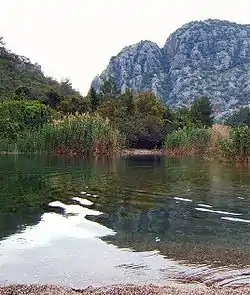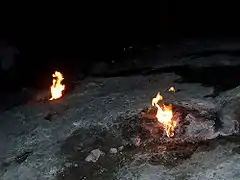Yanartaş
Yanartaş ([janaɾˈtaʃ], Turkish for "flaming stone") is a geographical feature near the Olympos valley and national park in Antalya Province in southwestern Turkey. It is the site of dozens of small fires which burn constantly from vents in the rocks on the side of the mountain. Directly below the fires are the ruins of the temple of Hephaistos, the Greek god who was associated with fire through his role as the blacksmith to the gods. To see the fires and the ruins, visitors must first go to the entrance at the foot of the mountain. The site is at the top of an easy one kilometre climb. Most people visit at night, when the fires are at their most spectacular.

In ancient times sailors could navigate by the flames, but today they are more often used to brew tea.
Ancient references
It has been suggested that the fires are the inspiration for the fire-breathing Chimera in Homer's Illiad.
The site was identified as the ancient Mount Chimaera by Sir Francis Beaufort in 1811, and described by T. A. B. Spratt in his Travels in Lycia, Milyas, and the Cibyratis, in company with the late Rev. E. T. Daniell. The discussion on the connection between the myth and the exact location of Chimera was started by Forbiger in 1844. The English archaeologist George E. Bean was of the opinion that the name was "allochthonous", meaning that it had originated somewhere else. He believed that the original location was further west, as cited by Strabo, at a location where similar fires burned.

Location
The location is 80 km southwest of Antalya, near the town of Çıralı. The area is located on a track popular with hikers and trekkers on the Lycian Way.
Fires
The fires are grouped over an area of 5000 m2 and are fueled by gas emissions which have been burning for at least 2500 years. These emissions seem to change seasonally: vents and flames are more vigorous in winter months. This is a common characteristic of such seeps, where gas flux is typically modulated by gas pressure build-up induced by groundwater recharge and changes in atmospheric pressure.[1][2]
Gas composition
The vents emit mainly methane (87%). The rest is made of hydrogen (7.5-11%), nitrogen (2-4.9 %), light alkanes (0.57%), carbon dioxide (0.01-0.07 %) and helium (80 ppmv). These proportions and the isotopic composition indicates a mix from 2 origins, in equal part:[1]
- an organic thermogenic gas, related to type III kerogen occurring in Palaeozoic and Mesozoic organic-rich sedimentary rocks,
- an abiogenic gas produced by low-temperature serpentinization in the Tekirova ophiolitic unit.
Source of gas
Abiotic methane ordinarily only forms at temperatures much higher than those that occur in the rocks at Yanartaş. However, ruthenium is present in the igneous rocks under the flames, and is believed to act as a catalyst, permitting the formation of methane at the lower temperatures (i.e., below 100 °C) that occur at Yanartaş.[2]
These vents represent the biggest emission of abiogenic methane discovered on land so far. The emissions do not have a volcanic origin, since methane is not related to mantle or magma degassing.[1]
References
- Hosgormez, H.; Etiope, G.; Yalçin, M. N. (November 2008). "New evidence for a mixed inorganic and organic origin of the Olympic Chimaera fire (Turkey): a large onshore seepage of abiogenic gas". Geofluids. 8 (4): 263–273. doi:10.1111/j.1468-8123.2008.00226.x.
- Etiope, Giuseppe; Ionescu, Artur (18 Sep 2014). Manning, Craig; Person, Mark; Worden, Richard (eds.). "Low-temperature catalytic CO2 hydrogenation with geological quantities of ruthenium: a possible abiotic CH4 source in chromitite-rich serpentinized rocks" (PDF). Geofluids (Journal). 15 (3): 438–452. doi:10.1111/gfl.12106. ISSN 1468-8123.
Books
- A.M. Celal Sengör (2003). The Large Wavelength Deformations in the Lithosphere: Materials for a History of the Evolution of Thought from the Earliest Times to Plate Tectonics p. 310 Endnotes. Geological Society of America. ISBN 978-0-8137-1196-6.
- George E. Bean (1978). Lycian Turkey. Ernest Benn, London. ISBN 978-0-510-03205-0.